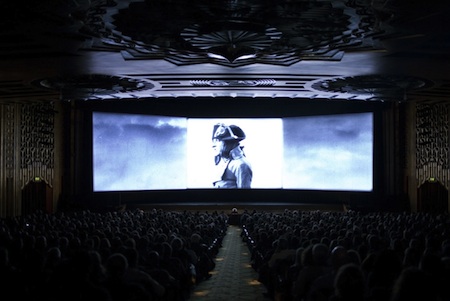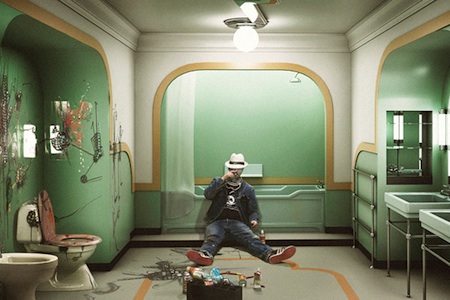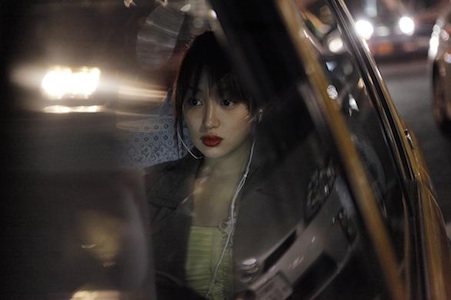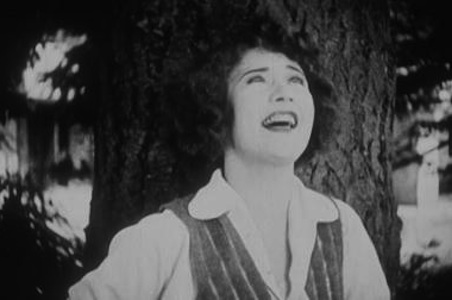
It was a year that, at the outset, didn’t offer much hope for film, but emerged with a consensus view at the final count: Keep the lights on. Of course Ira Sachs’ film of the same name was one of many that sparked optimism for the future of the personal vision and the big-screen experience of cinema. But hope sprung eternal via restoration presentations (the epic Napoleon), revivification projects (The White Shadow) and vivid moments of genius (Holy Motors). What follows are memories, appreciations and, of course, complaints about filmmaking trends and moviegoing experiences.
Cinematic events of 2012: Hands down the cinematic experience of 2012 for me was the American premier of the complete restoration of Abel Gance‘s Napoleon (1927) with live accompaniment by Oakland East Bay Symphony conducted by Carl Davis. The density of Gance’s ideas, the frisson of his images and experiments in cinematic expression, and the complicated perspectives on the legacy of Napoleon have a weight that is undeniable. And watching the full 5 ½ Napoleon with a live orchestra in a magnificent theater elevates the film to a cinematic experience without parallel, and that experience electrifies the storytelling and imagery.
—Sean Axmaker
Keep the Lights On: Ira Sachs’ drama (co-scripted by Maurizio Zacaharias) of the ten-year rise and fall of a love affair that’s as fulfilling as it is destructive is easily the best gay film since Those Who Love Me Can Take the Train. It’s based on Sachs own experiences with literary agent Bill Clegg (whose account of the affair can be read in his Portrait of an Addict as a Young Man), brought to vivid life through the performances of Thure Lindhart (as Sach’s stand-in) and Zachary Booth (as Clegg’s) with the songs of the late Arthur Russell adding to the intimate honesty
—David Ehrenstein
A Narrative Shorts Top 5
1. The Black Balloon (Benny Safdie, Josh Safdie)
2. Remote (Jesse McLean)
3. Arbor (Janie Geiser)
4. Another Void (Paul Clipson)
5. A Lax Riddle Unit (Laida Lertxundi)
—Jonathan Marlow
A Recontextualizations Top 3
1. Walt Disney’s Taxi Driver (Bryan Boyce)
2. The Clock (Christian Marclay)
3. Final Cut: Ladies and Gentlemen (György Pálfi)
—Jonathan Marlow
Maudlin thoughts on the end of an era: Richard Peña wields more languages than anyone should rightly be able to. He sleeps only a few hours a night. If he seems distant and distracted, he is probably five steps ahead of you instead of the usual three. His office is a terrifying, incomprehensible jumble of books, festival catalogs, and VHS tapes labeled in foreign tongues. He navigates this space as deftly as a librarian in scholarly stacks.
His passport black with visas and stamps, he hopscotches from Russia to China, from Israel to Iran, from Brazil to the Baltics, from Mesopotamia to Scandinavia. His taste in film, which is deeply informed by a fearsome, encyclopedic understanding of politics, geography and history, is unpredictable and stubborn, fearless and strange.
2012 is the year that Richard Peña, American film curator extraordinaire, retired as the Program Director at the Film Society of Lincoln Center after 25 years on the job.
Although largely unknown to lay-film goers, during that time he wrote countless film descriptions, program notes, essays, applications, recommendations, letters of request, letters of inquiry, letters of rejection and invitations. He championed the work of Youssef Chahine, Ritwik Ghatak, Kira Muratova, Bella Tarr, Abbas Kiarostami, Aki Kaurismaki, Claire Denis, Mike Leigh, Gabriel Figueroa, Yasujiro Ozu, Amitabh Bachchan, Pedro Almodovar, Ousmane Sembène, Hou Hsiao-hsien; filmmakers with names like a poem. His several annual international film series—Jewish, Italian, French, African, and others—each had a feisty selection committee that included members of the constituency in question; they remain a model for integrity and authenticity, choosing long hours over cut corners.
Pulp Fiction opened the New York Film Festival one year and an audience member had a heart attack. Yet no amount of Hollywood pressure could alter the programming of the Festival, a small and perfect gem, under his watch. He scoured national archives, museums, festivals, and private collections for films with the power to challenge and change what you thought you knew about a given nation, or about a people, or about yourself. And he shaped the way that world cinema is understood, contextualized, and respected in the United States. It’s enough to make me proud to be, not a Paulette, but a Peña-ette.
—Livia Bloom
Amour: While many believe Michael Haneke to be a cinematic sadist for such works as Cache, The White Ribbon and Code Unknown, you won’t find anything but compassion in this story of a loving elderly couple facing physical diminution and death. Screen legends Jean-Louis Trintignant and Emmanulle Rive cap their lengthy and distinguish careers with this dark masterpiece.
—David Ehrenstein
2012 was not a very good film year for all categories of film. Most of my favorites are festival films—films that took risks, told me stories I didn’t know, and/or reinvigorated classic forms. Signature event for me and the film community was cohosting For the Love of Film: The Film Preservation Blogathon III, which raised money for the score for the Graham Cutts/Alfred Hitchcock film The White Shadow (1924), which made its online repremiere with Fandor’s help in November. Most disturbing trend: more propaganda films were released. Most heartening trend: propaganda films flopped and had no effect on the general election results.
—Marilyn Ferdinand
Favorite film moments of 2013: Strolling through Muir Woods early one Saturday morning with Ken Burns (“The National Parks: America’s Best Idea,” among countless PBS series) and Raymond Santana (one of “The Central Park Five,” who had never been outside of New York state before this trip) en route to conducting a public interview with Burns at the Mill Valley Film Festival.
H.P. Mendoza’s colorful and blistering acceptance speech at the San Francisco Film Society’s annual Essential SF award ceremony, in which the director-writer-producer-composer-actor (Fruit Fly, I Am a Ghost, Colma: The Musical) uncompromisingly articulated the compulsions, responsibilities and rewards of the independent filmmaker.
—Michael Fox
As always, I’m holding onto the past through local rep-house programming. The Castro Theatre remains a bastion of cinephilia; thank you Keith Arnold and co. for The Swimmer, Straight Time, Days Of Being Wild, Love Streams, Nightmare Alley, Phantom of the Paradise and dozens more. And thanks to everyone at the Roxie and PFA, YBCA and SF Cinematheque, and all the local festival folk for providing an endless array of amazing films and experiences.
On the downside, the behavior of audience members at commercial theaters around town is frequently abominable. Turn your phones off, people, stop rustling your damned popcorn bags and shut the fuck up.
—Steven Jenkins
Movies might not be endangered but audiences are: At the press conference following a Festival do Rio screening of Holy Motors, the journalists in the room had less questions for the director than for pop star Kylie Minogue—What do you think of Brazil? How long will you stay in Rio? How did you handle working on such an explicit film? (I’m not lying). I was eager to hear from Carax, even (especially?) if he repeated his oft-quoted refrain that he despises digital cameras. He did not disappoint and said he made Holy Motors “out of a rage.” Rage borne of fifteen years unable to secure financing (until he shot digitally) and also, he said, a fear that the audience for movies was disappearing. I had almost left myself during the screening, frustrated by the journalists around me texting and tweeting, the blue light from their tiny twinkling screens bouncing off the edges of my eyeglasses onto my retina for two-plus hours. Despite my increasingly testy requests that they close their phones, they persisted, even afterwards, one commenting about the movie while prodigiously thumbing his device, “I expected more.” (He must have meant more Kylie.) Holy Motors begins with a shot of a full movie theater, the audience, shot from behind, immobile ghosts fixed to their seats. The audience might be physically in the room, but Carax is right, it is gone.
—Shari Kizirian
Un été brûlant: Philippe Garrel has in recent years specialized in films about unhappy love affars. Few have been as beautifully, extravagantly unhappy as this one starring his phenomenal son Louis and the lovely Monica Bellucci. Among its delights are scenes depicting Bellucci (who plays an actress) appearing in precisely the sort of commercial film Garrel has always abhorred.
—David Ehrenstein
Critic-turned-filmmaker Kleber Mendonça Filho told me during an interview that if someone had asked him as a kid to draw a picture of a taxi cab, he would’ve drawn the yellow New York cab ubiquitous in the American films he grew up watching in Recife, Brazil’s fifth largest city. He cited the subversive humor of John Landis and the widescreen suspense of John Carpenter and Roman Polanski as indelible entries in his movie memory bank. “Some films are like germs or microbes in your head. You don’t say, ‘I’m going to make a film under the sign of Renoir.’ You realize only later that John Landis or John Carpenter was sitting beside you.” Filho’s first fiction feature so impressed me that I sought out his other works available online, several shorts set among the same environs and circumstances found in Neighboring Sounds and a feature-length documentary about film criticism. Crítico (2008) is a compelling patchwork of interviews with the likes of Michel Ciment, Deborah Young (Variety), Elia Suleiman (whom Filho also listed as another “germ” that invaded his 2005 short, Eletrodoméstica), Samuel L. Jackson (being asked at a press conference what it was like working on The Matrix films), and many other critics, directors, and actors, all commenting on the relationship between the press and cinema. A former critic for a Recife daily, Filho says he sees fewer movies now that he’s making them. He needed the break after writing about a film a week and also complained about the moviegoing experience.“I get angry at bad film projection, bad sound … and the audiences,” he said, “are rude.”
—Shari Kizirian
The Deep Blue Sea: Rachel Weisz is astonishing in this adaptation of Terence Rattigan’s play (which starred Vivian Leigh on the West End) about a ruinous adulterous affair. There’s nothing “filmed theater” about Davies approach to the material in which postwar British angst is subtly underscore.
—David Ehrenstein
A Series of Souvenirs:
BAFICI, where Gaston Solnicki (Papirosen) and Goncalo Tocha (It’s Not the Moon, It’s the Earth) fulfill their promise; press screenings of Tabu are ‘sold out’ while Miguel Gomes can be found in archaic billiard halls watching football; and J. Hoberman’s works, translated into Spanish, are devoured by young cinephiles….
Telluride Film Festival, where Joshua Oppenheimer (The Act of Killing) takes an enigmatic Q&A session outside the theater, beneath a canopy, late into the night; and Geoff Dyer and Errol Morris square off in the town courthouse on the subject of ‘truth’ in art…..
San Sebastian Film Festival, where the red carpets were trampled by a general citywide strike, and a young Chilean filmmaker snares a top award for a decidedly unglamorous film (Carne de Perro, Fernando Guzzoni).
The Sensory Ethnography Lab at Harvard, where Leviathan began its long swim out to sea, and Lucien Castaing-Taylor presides over student work certain to sear the upcoming cinematic year: Manakamana, here’s to waiting for you.
—Jay Kuehner
I’m excited to see more directors and even some studios take advantage of the possibilities of video on demand. I can spend six bucks and watch Marfa Girl in my living room, and that’s pretty exciting. I think I’ll do that right now, in fact.
—Ian Miller
An odd but pleasing year from film in which I rarely saw something that made me exclaim “ah hah! Perfection!” but had several experiences where I felt film was alive again (in whatever format it’s projected in) including the almost literal jaw-dropping by the end of Holy Motors. Even 3-D projection had its moments, as in the submersive affect of watching Life of Pi, an imperfect film narratively but still emotionally engaging and enhanced by the 3rd dimension. It felt like many risks were taken this year, including in Anderson’s also imperfect but fascinatingly so epic character study (those two things not always mutually exclusive). I left the year feeling less cynical about our cinematic future, so there’s that.
—Craig Phillips
How To Survive a Plague: One of several documentaries that have recently appeared about the AIDS pandemic, first-time filmmaker David France zeroes in on the way leaders in the fight not only battled public and governmental indifference, but challenged medical authorities as well—empowering AIDS sufferers and changing doctor/patient relationships acrss the board.
—David Ehrenstein
My highlight of the year was being floored by Abbas Kiarostami‘s masterpiece Like Someone in Love at its Cannes World Premiere with a fidgety audience of walkouts and confused critics sandblasted by what they just witnessed.
—Glenn Heath Jr.
Local (Seattle) Event: Joe Dante’s “The Movie Orgy, ” one-night-only at Grand Illusion. It was a perfect marriage of film and venue: the tiny, independent house with a storied history and an audience of regulars, and a scrappy compilation movie with some surreal moments and a climax that manages to bring over dozen films into the same narrative universe, if only for this moment. And hey, don’t crowd me, man.
—Sean Axmaker
I quite enjoyed Tony Scott’s “Film Culture Isn’t Dead After All” piece in the NYT, written in answer to Davids Denby and Thompson whines about it supposedly being all over. It’s not.
—David Ehrenstein
Having seen The Master in 70mm and then The Hobbit in 48fps/hfr, I realize that I do not need to see my dreams in HD. If the latter is the future of film, then I’m even more nostalgic for its past. What’s gained by this “innovation” is minimal, and what’s lost—poetry—is immeasurable.
—David Fear
Masters, revisited
Carl Theodor Dreyer (London, March 2012)
Vincente Minnelli (London, April-May 2012)
Jean Grémillon (Bologna, June 2012)
—Ehsan K hoshbakht

Moonrise Kingdom: Wes Anderson’s delightful romantic comedy centers on two wise-beyond-their year pre-teens (Jared Gilman and Kara Heyward) whose love for one another confounds a pack of silly, confused romantically needy adults (Bill Murray, Bruce Willis, Frances McDormand, Tilda Swinton) it also testifies to the pop musical power of Francoise Hardy.
—David Ehrenstein
Encounters:
Claude Lanzmann’s dark humor on his masterclass at the Cine Lumiere, London, was a strange complementary to that breathtaking and terrifying power of Shoah.
The iconic shoe designer, Manolo Blahnik in conversation with actress Diana Quick about Divorce Italian Style and the castles of south Italy at the National Film Theatre, London. Taught me how cinema is still in need of angles and views which one hasn’t thought of.
Foster Hirsch, an Otto Preminger and film noir authority, in conversation with recently rediscovered Jack Garfein, after the screening of his European-influenced Something Wild at the BFI. The audience became emotional when he thanked the English for liberating him from concentration camp as a boy of fifteen.
—Ehsan Khoshbakht
Special Mention: Margaret: Director’s Cut (Kenneth Lonergan): After Fox all but dumped the film, Seattle didn’t get Kenneth Lonergan’s long-delayed second feature, shot in 2006 and “officially” released in 2011, until well into 2012. I don’t know that the longer “Director’s Cut,” which debuted around the nation as an exclusive bonus DVD on the 2012 Blu-ray release, is better than the original cut—Lonergan himself has taken pains to say that both versions are director’s cuts—but it is at least as rewarding an experience as the theatrical release, just as rich, a little messier and more sprawling. Runners-up and honorable mentions: Deep Blue Sea, Amour, Magic Mike, Lincoln, Django Unchained, Cloud Atlas, The Hunt
—Sean Axmaker
Worst Movie of 2012: The Hunger Games
—Nelson Carvajal
Watch the video essay on my Top 10 list on Vimeo: Keyframe Video: Nelson Carvajal’s Ten Best Films of 2012 from Nelson Carvajal on Vimeo.
—Nelson Carvajal
Bernie: Richard Linklater’s so-outrageous-it-has-to-be-true “based on a true story” tells of how the sweet beloved assistant funeral director in a small Texas town, came to befriend its most unloved citizen and later murder her. Jack Black in the role he was born to play is broad and subtle at the same time. As the object of his ambiguous attention Shirley Maclaine seems to stand back and watch in awe as That Young Black Magic weaves its spell.
—David Ehrenstein
The Rolling Stones: Charlie Is My Darling—Ireland ’65 (Peter Whitehead, Mick Gochanour, 2012): In spite of the controversy over The Rolling Stones’ overpriced tickets for the 50th anniversary concerts and the banality of the specially commissioned documentary, Crossfire Hurricane, this first-rate rockumentary can be compared to Don’t Look Back, with the same amount of truth revealing, agression and humor. While the official Crossfire Hurricane shows Stones in a sloppy collage of famous films we have seen before—without daring to include any explicit footage from the dark side of the band in Cocksucker Blues—this cine-vérité piece serves the purpose as a brilliant portrayal of five naïve people, growing fast and moving from blues covers to strong personal statements about sex and death.
—Ehsan Khoshbakht
Laurence Anyways: French-Canadian wunderkind Xavier Dolan’s romantic drama moves him right to the queer filmmaking forefront in this story of the ups and downs of a ten-year love affair (is this a trend?) that isn’t fundamentally altered when the party of the first part decides to change his gender. The amazing Melville Poupaud is the transgender in question, and Suzanne Clement is every bit as powerful as the woman he loves too well but not at all wisely.
—David Ehrenstein
Jerry & Me (Mehrnaz Saeed-Vafa, 2012): Not only a master class on the art of Jerry Lewis but a highly confessional autobiography of an Iranian-American woman who, adoringly, sees her life projected in the films of a Jewish American comedian.
—Ehsan Khoshbakht
Reconversão (Thom Andersen, 2012) A very pleasant documentary about the Portuguese architect, Eduardo Souto de Moura whose fascination with ruins and transforming them into modern buildings is the main theme of his works and also this film’s. Anderson, deliberately, avoids interviewing Souto de Moura till nearly the end of the film, but, still, the filmmaker’s independency and personal vision allows him to draw an accurate plan of the architect’s thoughts and methods. At the end, and after 65 minutes of still shots from Souto’s works, he truly looks like a passionate Mies van der Rohe who idolizes Miles Davis and Ahmad Jamal.
—Ehsan Khoshbakht
The Pervert’s Guide to Ideology (Sophie Fiennes, 2012) and Room 237 (Rodney Ascher, 2012): If you take them as comedies, you’ll find them hilarious. If you take them as dramas, you’ll have a chance to see the dark side of film studies and cinephilia in the age of digital. In both cases, it’s difficult to stay unimpressed with the massive comedy potentials of Slavoj Žižek and also those who have found a new Messiah in Kubrick.
—Ehsan Khoshbakht
The Perks of Being a Wallflower: It’s very rare that a novelist gets to adapt his own work to the screen, and even rarer that it be done so well. But Stephen Chbosky has done a beautiful job with his tale of a shy outsider who “finds his tribe.” Logan Lerman is marvelous as the anti-hero. Harry Potter veteran Emma Watson is delightful as his first love, and Ezra Miller is Beyond Fabulous as more-than-openly-gay “Island of Misfit Toys” clubhouse leader Patrick.
—David Ehrenstein
Three Cinematic Surprises this Year: As a cinephile, I spend much of my year in anxious anticipation of upcoming films. These might be films made by individuals with whom I am familiar, or films made by people I know nothing about except from the praise I read on the web, in magazines, or hear about on podcasts and in conversation with folks similarly afflicted with cinephilia. The next interesting film coming around the corner is a big part of what keeps my spirits up. Great (or even simply good) cinema is a Prozac ingested through haptic means by the flickering images on my eyes.
Then there are the films I stumble into because my local theatre or a festival has placed it on their schedule. I barely read the synopsis, if I read it at all. It’s a film of convenience curated by others. It works its way into the limited time frame I have that day to watch a film. And occasionally they surprise. Before I was much of a cinephile, I remember seeing Once Were Warriors with a friend because the movie (now forgotten) in the St. Louis Galleria mall cineplex we wanted to see was sold out. We both walked in knowing nothing much about New Zealand let alone this film. Once we were struck with its power, we would never forget this film.
So I decided to focus my contribution to the Keyframe Year in Film Poll 2012 around films I thoroughly enjoyed that were released or festival premiered this year and there were films I knew nothing about before I entered the theatre or nestled them into my DVD player. One was viewed at the Tiburon International Film Festival in Northern California. One I saw on a DVD screener that gripped me in spite of my preference to watch films on movie screens as opposed to TV screens. And finally, one is thanks to the local theatre, La Scala, in my wife’s hometown, Yamaguchi City, Yamaguchi, Japan, a theatre that sadly closed its doors before year-end.
Raw Material (Hristos Karakepolis, Greece): Greece’s place at the bottoming out of the Global Financial Crisis is told perhaps no more powerfully than in this documentary about those in the scavenger trade in Greece. I saw this at the Tiburon International Film Festival in an empty theatre, my wife and I the only folks present. This lonely viewing added to the eerie feel of the film about the sadness of alternate economies surviving off the unsustainable excess of others.
A Letter to Momo (Hiroyuki Okiura, Japan): Not only did I know nothing about this film going in, it was unsubtitled in a language I can barely babble in. Still, the film’s patient story about a young girl working through the death of her father with the help of some gluttonous, but somewhat friendly, demons can be followed fairly faithfully through the tone sans comprehension of the dialogue. The goofy little dance scene still makes me chuckle, enhanced in my body memory by teaching the dance to my nieces afterwards, and I’m still reveling in the spectacularly psychedelic tunnel manifesting at the end.
Boundary (Benito Bautista, Philippines): This was a screener for the New Filipino Cinema series at Yerba Buena Center for the Arts that I slipped into my DVD player that I planned to watch in segments due to a busy week. I ended up staying awake way later than I should have on a work night. I couldn’t pull myself away from this neon noir fueled by the anxiety of a mysterious passenger and nervous driver sharing a taxi ride in Manila during the Christmas season of Holy Week. It’s a genre film that speaks of economics, class, regional specificity, and the mundane of the everyday, while never forgetting to entertain you along the way.
—Adam Hartzell
Holy Motors: Leos Carax’ latest about a certain “Monsieur Oscar” (Denis Lavant bien sur) going on a series of late night “appointments” accompanied by his chauffeur (the iconic Edith Scob) is totally bonkers yet makes complete sense at the same time. Among its delights a marvelous musical turn by disco pixie Kylie Minogue.
—David Ehrenstein
For three consecutive Sundays in June my boyfriend and I made a pilgrimage to Berkeley’s Pacific Film Archive for the church-like experience of Nathaniel Dorsky screening and then holding forth on the mesmerizing short films he has made during the last decade or so, and the loving, almost anthropomorphized descriptions he gave of the film stock he used to make each of them implicitly voiced cinema’s biggest issue of 2012 that no one seems to really want to talk about: that for all of the multiplicity digital formats seem to promise us as viewers, the dwindling availability of film stock as well as the equipment, expertise and venues able to project film prints means we are losing an important and vital way of experiencing and understanding cinema. While I am endlessly grateful for the many options available to me as a viewer in






